Ready for Some Serious Diving in Southeast Asia ?Prepared by Harold Stephens
Travel Correspondent for Thai Airways International
It’s not for the casual scuba diver, diving on lost wrecks, but for the experienced diver it is possible. The bottom of the ocean floors of Southeast Asia is littered with wrecks, both ancient and recent, wrecks that are waiting to be discovered.
It’s hard to imagine that prior to World War II divers had to use hard hats with pumped-in air to explore ocean bottoms. Diving was limited to professionals only. Then came the development of scuba diving equipment and a whole new era in underwater exploration began.
Marine archaeology for the scholar was now possible and another very profitable pastime took on new dimensions—treasure hunting. What started in the Mediterranean as a search for Greek and Roman amphora-laden galleys eventually led to the quest for sunken gold-laden Spanish vessels in the Caribbean.
Such discoveries in the Caribbean are common. Records show that in the waters around Florida alone Spain lost some 381 vessels in a period lasting less than 150 years. And nearly every ship lost was carrying gold, silver or precious stones, in some instances all three.
Until very recently, marine archaeology and treasure diving was concentrated in the Mediterranean and the Caribbean. Then in the late 1970s, Thai fishermen found a sunken Chinese junk off their southern Sattahip coast, and a new world of exploration opened up.
On hundreds of previous occasions, Thai fishermen had found bits of pottery in their nets but had not thought much about it. But when they brought back three unbroken pieces which they had untangled from their nets, and were offered a handsome price by an art dealer, the picture changed. The fishermen returned to the site and collected 82 more ceramics, which they sold for a reported US$1,500. The quest was on.
The Sattahip incident highlighted the fact that the Asian undersea world is virtually unexplored. Yet the history of the region is filled with accounts of sea voyages, voyages that had certainly resulted in countless wrecks that had scattered their remains on the ocean floor.
China had been sending her junks on expeditions of trade and exploration to far reaches of Asia for some 2000 years. Commerce in the area was active when Rome was only a minor trading post. Ships of a dozen eastern nations plied the Asian seas for centuries and how many spilled their treasures on uncharted coasts or submerged coral reefs?
The biggest difficulty with marine archaeology is finding sunken vessels in the first place. Even after they have been reported lost in a given area the problem is not solved. Survivors from a shipwreck are less than accurate in fixing positions. Even more confusing is the fact that most vessels go down on the windward sides of reefs, where their bottoms are torn out by coral. Considering that coral can grow a centimeter a year, only a few years are needed for a ship, with its cannons, anchors and cargo, to lose its distinctive shape and outline. And wooden hulls, within a few years, unless protected by sand or mud, will be eaten away by worms.
But even more destructive is the sea itself. Chemical action between salt water and iron objects eventually converts such things as cannon balls into virtually pure hematite. Wrought iron merely disintegrates. Silver becomes silver sulfide. Copper or brass becomes encrusted with a patina. Pottery or earthenware becomes overgrown with oyster shells. Three commonly found metals that are virtually immune to destruction by seawater or time are tin, lead and gold.
The lack of modern, and expensive, diving equipment need not be an excuse for not going exploring on your own. All one needs, aside from basic equipment, is some know-how, spirit and a lot of luck to find an undersea world of adventure.
War wrecks have always been the object of keen salvage operators and both the South Pacific and Southeast Asia have untold wrecks beneath their seas. To explore these wrecks, I built and outfitted my own 71-foot schooner, Third Sea, and for eighteen years sailed Asian and South Pacific waters, touching upon many islands that were battle sites during World War II. We came upon airstrips with bombers and fighters still on the runways; harbours with dozens of sunken ships, some in water so shallow we could see them below the surface; caves filled with rusting arms, helmets and mess gear; heavy brass cannons hidden in lonely mountain outposts; and other islands where the military simply walked off when it was all over and left everything behind. I wrote in detail about this in my books “The Last Voyage” and “Return to Adventure Southeast Asia.”
Most divers have heard of Truk Island in the Carolines. It was here that much of the Japanese navy was finally bottled up and sunk. A place that is even more spectacular is Rabaul on the island of New Britain. Rabaul was one of the most important targets in the Pacific war. The Japanese captured the port two months after they bombed Pearl Harbor and immediately began constructing one of the toughest, most formidable bastions ever built. It was virtually impregnable. The combined allied forces dropped more than 20,000 tons of bombs on the place. The Allies never tried to recapture Rabaul as it was easier and cheaper to simply bypass it and starve it out.
The Japanese at Rabaul surrendered only when the war ended. The Allies came ashore and found 90,000 Japanese, civilians and military, living in an amazing subterranean world, 580 kilometers of caves into which ships and even submarines were pulled when air attacks threatened them.
Some allied bombers had found success. Records show that more than 400 known wrecks lie at the bottom of Rabaul bay, including an American submarine. Only a handful of these wrecks have been explored by divers. One reason is because it’s a deep harbor.
I met several weekend divers when I sailed into Rabaul. One Australian engineer and his sixteen-year-old son had been working the harbour for three years. He told me, off the record, that he had earned enough to retire for life, bringing up brass shell casings and selling them to the Chinese. He was an underwater photographer and had hundreds of photos of sunken vessels, including a Japanese Zero in shallow water, virtually intact.
The Solomon Islands, South of Rabaul, are where some of the heaviest fighting of the Pacific war took place. As I have mentioned, entire airfields were lost and forgotten and in some bays entire squadrons of ships went down to the bottom. Here in the Solomons, I dove on the site of President Kennedy’s sunken PT-109. But that’s another story.
Divers don't have to look to war wrecks for excitement. Hardly an island or an atoll that we visited didn't have at least one Korean or Taiwanese fishing boat piled up on the reef. Some larger islands had two or three. On inhabited islands, natives clean out the cargo, leaving the ships with valuable equipment to rust and to be slowly broken up by the pounding sea.
In Southeast Asia, a whole new field of undersea exploration is taking place. The discovery by Australian Mike Hatcher of a Dutch ship sunk in 1724 off the east coast of Malaysia made history a few years ago when he and his divers brought up elephant tusks and tin ingots worth millions. Later, Mike had found the famous Nanking wreck, a find that Christi’s in London auctioned off for a reported US$36 million.
Such diving is not for everyone but for those who want to do some regular scuba diving ask your nearest TG office for the Special Interest Holidays booklet. I have also written about diving and other adventures in my book “Return to Adventure.” Write to me about how to get your autographed copy.
Harold Stephens
Bangkok
E-mail: ROH Weekly Travel (booking@inet.co.th)
Note: The article is the personal view of the writer and does not necessarily reflect the view of Thai Airways International Public Company Limited. | 
Thai Airways has its own drive team | | 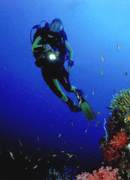
Diving in Southeast Asia can be among beautiful coral | | 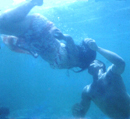
In Tahiti diving has another dimension | | 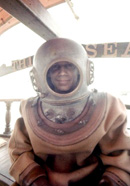
Hardhat diving gear aboard author’s schooner | | 
Modern diving vessel in Phuket, Thailand | | 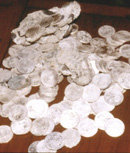
Silver coins brought up from one wreck | | 
HMS Repulse sunk off coast of Malaya in opening days of war | | 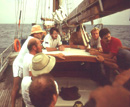
Planning the dive on Repulse was important
| | 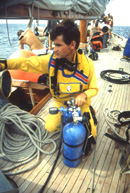
Each diver checks his own equipment
| | 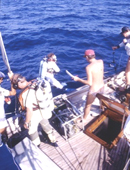
Tense moment going over the side
| | 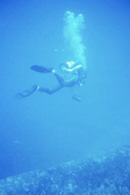
Reaching Repulse hull at 180 feet
| | 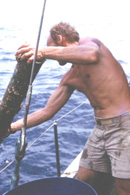
Bringing up shell casing from Repulse
| | 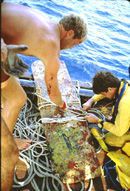
Bringing up the Repulse nameplate covered in barnacles
| | 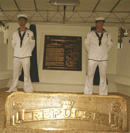
The nameplate now in a museum in London
| | 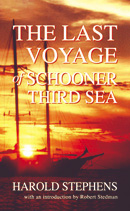
The author’s book tells the story of finding the Repulse
|
|





